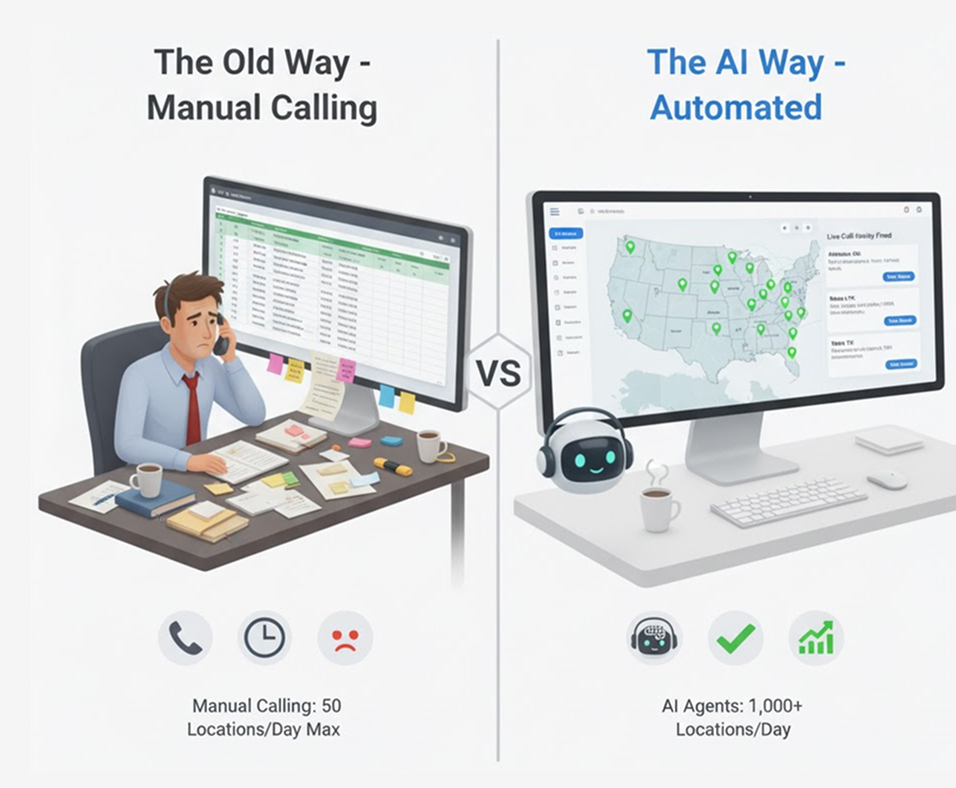How to Automate Inventory Verification Without RFID (2025 Guide)
Introduction
If your logistics team is spending hours calling warehouse locations, retail stores, or distribution centers to check if inventory is ready for pickup, you're not alone. Manual inventory verification is one of the most time-consuming—and error-prone—processes in supply chain management.
The result? Trucks dispatched to empty locations. Wasted fuel costs. Frustrated drivers. And returnable assets that mysteriously "disappear" because no one followed up in time.
According to industry research, companies lose between 20-40% of their returnable assets annually due to poor tracking and verification processes. Each lost pallet, container, or display rack can cost anywhere from $200 to $5,000 to replace.
But here's the good news: inventory verification doesn't have to be manual, expensive, or require massive infrastructure changes.
In this guide, we'll show you how AI phone calling agents are transforming inventory verification—enabling companies to verify asset status across thousands of locations daily, without installing a single RFID tag or GPS tracker.
The Traditional Inventory Verification Problem
Manual Calling Doesn't Scale
Most companies with distributed inventory networks—whether managing returnable packaging, consignment inventory, or field assets—rely on one of two approaches:
Option 1: Manual Phone Calls
- Operations teams call locations to verify inventory status
- Time-consuming and can't scale beyond 50-100 calls per day
- Inconsistent data capture (missed information, incomplete notes)
- High labor costs for repetitive work
Option 2: Wait for Locations to Call You
- Hope that warehouses, stores, or customers notify you when assets are ready
- Low response rates (locations are busy and forget to call)
- Delayed pickups mean assets sit longer, increasing loss risk
- No proactive visibility into asset availability
Neither approach works when you're managing 500+ locations or dealing with high-value returnable assets.
The "RFID Solution" Is Expensive and Complex
When companies realize manual calling isn't sustainable, they often turn to RFID, GPS trackers, or IoT sensors.
The reality of hardware-based tracking:
- High upfront costs: $5-25 per RFID tag, plus readers, infrastructure
- Installation complexity: Requires site visits, equipment setup, training
- Ongoing maintenance: Hardware breaks, batteries die, tags get damaged
- Limited adoption: Not all locations can support the infrastructure
- Geographic limitations: GPS doesn't work indoors; RFID needs readers at checkpoints
For a company with 1,000+ retail locations or a distributed supplier network, hardware-based tracking can cost hundreds of thousands of dollars to implement—before you even account for maintenance.
The question becomes: What if you could get real-time inventory verification without the hardware?
The New Approach: AI Phone Calling Agents for Inventory Verification
What Are AI Phone Calling Agents?
AI phone calling agents are software-based systems that make and receive phone calls just like a human would—but at scale, 24/7, with perfect consistency.
Unlike traditional IVR systems (press 1 for this, press 2 for that), modern AI agents use natural language processing to have real conversations. They can:
- Ask questions and understand responses
- Handle objections and follow-up questions
- Capture detailed information accurately
- Schedule callbacks or appointments
- Sync data to your CRM, ERP, or TMS in real-time
For inventory verification, this means AI agents can call your locations daily—or even multiple times per day—to check on asset status, without requiring any human intervention.
How AI-Powered Inventory Verification Works
Here's the typical workflow:
Step 1: Automated Outbound Calls
- AI agent calls your list of locations (warehouses, stores, distribution centers)
- Calls can be scheduled (daily at 9 AM) or triggered by events (shipment delivered yesterday)
- Scales instantly from 10 calls to 10,000 calls per day
Step 2: Natural Conversation
The AI agent asks questions like:
- "Hi, this is calling on behalf of [Your Company]. Do you have any empty pallets ready for pickup?"
- "How many containers are available?"
- "When would be a good time for us to schedule pickup?"
The AI understands different responses:
- "Yes, we have 12 racks ready"
- "Not right now, check back next week"
- "Let me check... hold on..."
Step 3: Data Capture & System Updates
- Every call is automatically transcribed
- Key information (quantity, location, availability date) is extracted
- Data syncs to your systems in real-time
- You get a dashboard showing: 🟢 Ready for pickup | 🟡 Callback later | 🔴 Nothing available
Step 4: Smart Routing & Dispatch
- Only locations with confirmed inventory show up on pickup schedules
- Route optimization based on real verified data
- No more guessing which locations to visit
Step 5: Continuous Optimization
- AI learns which locations respond best at what times
- Automatically retries no-answers at optimal times
- Improves conversation flow based on successful calls
Real-World Example: Returnable Asset Tracking
Let's say you're a beverage distributor managing reusable kegs across 1,500 bars and restaurants:
The Old Way:
- 2-3 team members spend all day calling locations
- Can reach maybe 100-150 locations per week
- Inconsistent data ("I think we have some kegs, but I'd have to check")
- Trucks often arrive to find nothing ready
- 30% of kegs go missing annually
With AI Phone Agents:
- AI calls all 1,500 locations every Monday
- 85-90% contact rate (AI retries optimal times)
- Precise data: "We have 8 kegs ready for pickup this Thursday"
- Dispatch only visits locations with confirmed inventory
- Keg loss drops to under 10%
The result: 40% fewer wasted trips, 35% improvement in asset recovery, and your team focuses on high-value work instead of making calls.
Benefits of AI-Powered Inventory Verification
1. Scale Without Limits
Traditional manual calling:
- 1 person = ~50-80 calls per day max
- Need to hire more people to scale
- Labor costs increase linearly with call volume
AI phone agents:
- Handle 1,000+ calls simultaneously
- Scale from 100 to 10,000 calls with zero additional cost
- 24/7 availability (call after-hours, weekends, holidays)
2. Perfect Consistency
Human callers have bad days, miss details, forget to ask key questions. AI agents:
- Follow the exact same script every time
- Never miss a data point
- Capture information in standardized format
- No training drift or quality issues
3. Eliminate Wasted Trips
When you verify inventory status before dispatching trucks:
- 40% reduction in unsuccessful pickup attempts (typical result)
- Lower fuel costs
- Better driver utilization
- Improved customer satisfaction
4. Reduce Asset Loss
Proactive calling catches issues before they become losses:
- Regular check-ins keep assets top-of-mind for locations
- Early identification of missing or "stuck" inventory
- 30-50% improvement in recovery rates
- Lower replacement costs
5. Real-Time Visibility
Get a live dashboard showing:
- Which locations have inventory ready NOW
- Which locations to follow up with next week
- Historical patterns (Location X always has assets ready on Fridays)
- Predictive insights for better planning
6. No Hardware Installation
Unlike RFID or GPS tracking:
- No site visits required
- Works with any location that has a phone
- No equipment to maintain or replace
- Deploy in days, not months
7. 5X Better ROI Than Manual Calling
Cost comparison for 1,000 locations:
Most companies see ROI within 30-60 days.
Use Cases: Who Benefits from Automated Inventory Verification?
Food & Beverage Distributors
The Challenge:
Managing returnable kegs, crates, and totes across hundreds of bars, restaurants, and retailers. High loss rates. No visibility into what's ready for pickup.
The Solution:
AI agents call locations weekly to verify available inventory. Capture exact quantities and schedule pickups directly.
Impact:
- Reduce keg loss by 40%
- Improve pickup efficiency
- Better supplier relationships
Nursery & Garden Supply Companies
The Challenge:
Display racks and rolling cages at 1,000+ garden centers nationwide. Manual calling doesn't scale. Racks "disappear" or sit for months.
The Solution:
Daily or weekly automated calls to retail locations asking: "Do you have empty racks ready for pickup?"
Impact:
- 40% fewer wasted pickup trips
- Better rack turnover
- Lower replacement costs
Manufacturing with Returnable Containers
The Challenge:
Reusable plastic containers and pallets circulating between suppliers, factories, and warehouses. Poor visibility leads to ordering excess containers.
The Solution:
AI verifies container availability at supplier sites before scheduling pickups. Ensures containers flow back efficiently.
Impact:
- Reduce container fleet size by 25%
- Better capacity planning
- Lower working capital tied up in containers
3PL & Logistics Providers
The Challenge:
Managing customer-owned returnable packaging across multiple client networks. Each client wants different reporting and verification schedules.
The Solution:
Automated verification calls customized per client, with data feeding into client-specific dashboards and reports.
Impact:
- Scale service offering without adding headcount
- Higher client satisfaction
- New revenue opportunities
Retail Display & Fixture Programs
The Challenge:
Promotional displays, endcaps, and branded fixtures at retail locations. Need to know when to retrieve for the next campaign.
The Solution:
AI calls stores at campaign end to verify display availability and schedule pickup appointments.
Impact:
- Maximize fixture reuse
- On-time campaign launches
- Lower display procurement costs
How AI Inventory Verification Compares to Other Solutions
AI Phone Agents vs. RFID Tracking
When to use which:
- RFID is ideal for: High-value assets moving constantly through controlled environments (warehouses, factories)
- AI calls are ideal for: Distributed networks, periodic verification, locations without infrastructure
AI Phone Agents vs. Manual Calling
AI Phone Agents vs. GPS Trackers
When to use which:
- GPS is ideal for: High-value mobile assets (trailers, containers in transit)
- AI calls are ideal for: Stationary assets at known locations, verifying pickup readiness
How to Implement AI-Powered Inventory Verification
Step 1: Define Your Verification Workflow
Start by mapping your current process:
- Who needs to be called? (stores, warehouses, suppliers)
- What information do you need? (quantity, condition, timing)
- When should calls happen? (daily, weekly, event-triggered)
- How should data be used? (dispatch, reporting, forecasting)
Step 2: Set Up Your AI Agent
Working with an AI phone agent provider like OneAI:
- Upload your location list (names, phone numbers, addresses)
- Define the conversation flow - For example: "Hi, this is calling from [Company]. Do you have [asset type] ready for pickup?"
- Configure data capture - What fields to extract (quantity, date available, contact name)
- Set calling schedule - Daily at 9 AM? Weekly on Mondays?
- Connect integrations - Sync to your CRM, TMS, or ERP
Most platforms are live within 3-5 days.
Step 3: Start with a Pilot
- Don't call all 1,000 locations on day one:
- Start with 50-100 locations
- Test conversation flow
- Refine based on feedback
- Verify data accuracy
- Get buy-in from operations team
Step 4: Scale Up
Once the pilot proves ROI:
- Expand to full network
- Add more verification questions
- Implement advanced routing
- Enable direct calendar booking
Step 5: Optimize Continuously
AI systems get better over time:
- A/B test different conversation scripts
- Adjust calling times based on contact rates
- Add new use cases (appointment reminders, status updates)
- Analyze trends for predictive insights
Measuring ROI: Key Metrics to Track
Operational Efficiency Metrics
Before AI:
- Calls per day: 50-80
- Contact rate: 40-60%
- Data completeness: 70%
- Time per call: 8-12 minutes
After AI:
- Calls per day: 1,000+
- Contact rate: 85-90%
- Data completeness: 100%
- Time per call: 2-4 minutes (automated)
Cost Savings Metrics
Reduced Wasted Trips:
- Baseline: 40% of pickups find nothing ready
- With AI verification: 10% unsuccessful pickups
- Cost per wasted trip: $150 (fuel + labor)
- Annual savings: $180,000 (for 100 weekly pickups)
Improved Asset Recovery:
- Baseline: 30% asset loss annually
- With AI verification: 10% asset loss
- Average asset value: $500
- 10,000 assets in circulation
- Annual savings: $1,000,000
Labor Cost Reduction:
- 2 FTE making calls: $144,000/year
- AI phone agents: $36,000/year
- Savings: $108,000/year
- ROI: 300%
Common Questions About AI Inventory Verification
"Will locations know they're talking to AI?"
Modern AI voice technology is remarkably human-like. In most cases, the person on the other end won't realize it's AI unless you tell them. However, some companies choose to be transparent: "This is an automated assistant calling from [Company]..."
"What if someone asks a question the AI doesn't know?"
AI agents are designed to handle common questions and gracefully escalate when needed:
- "That's a great question. Let me have someone from our team call you back to discuss."
- Can transfer to a human in real-time if configured
- Logs the question for follow-up
"What about language barriers?"
Most AI phone agent platforms support multiple languages. You can configure different agents for English, Spanish, French, etc., based on location.
"How do you handle voicemail?"
AI agents can:
- Leave concise voicemails asking for callback
- Send follow-up text/email after voicemail
- Auto-retry at different times
- Escalate after X unsuccessful attempts
"Can AI integrate with our existing systems?"
Yes. Most AI phone agent platforms integrate with:
- CRMs (Salesforce, HubSpot, Zoho)
- ERPs (SAP, NetSuite, Oracle)
- TMS platforms (fleet management systems)
- Custom APIs
Data flows automatically both ways.
"What if our locations don't like automated calls?"
Some tips for smooth adoption:
- Notify locations in advance: "We're implementing an automated system to make scheduling easier"
- Keep calls brief and respectful: Get to the point quickly
- Provide value: "This helps us schedule pickups when it's convenient for you"
- Offer opt-out: "Press 1 to speak with a team member instead"
Most locations appreciate the consistency once they understand the benefit.
Real Results: What Companies Are Achieving
While we can't share specific customer names without permission, here are aggregated results from companies using AI phone agents for inventory verification:
Beverage Distribution Company (1,200 locations)
- 40% reduction in wasted pickup attempts
- 35% improvement in keg recovery rates
- $250K+ annual savings in logistics costs
- Deployed in 5 days, ROI in first month
Garden Supply Distributor (10,000+ retail locations)
- Automated status checks across entire network
- Eliminated 2 FTE positions ($144K/year savings)
- Better rack turnover and availability
- Can now scale to new retail partners without adding staff
Manufacturing Company (Returnable Containers)
- 25% reduction in container fleet size needed
- Better supplier coordination
- Reduced working capital tied up in containers
- Real-time visibility into container availability
Getting Started: Next Steps
1. Calculate Your Potential ROI
Ask yourself:
- How many locations do we need to verify?
- How often? (daily, weekly, monthly)
- What does a wasted trip cost us?
- What's our current asset loss rate?
- How much do we spend on manual calling?
Use these numbers to estimate savings.
2. Pilot with AI Phone Agents
Start small to prove the concept:
- Select 50-100 pilot locations
- Define success metrics (contact rate, data accuracy, cost savings)
- Run for 30 days
- Measure results vs. baseline
3. Scale Across Your Network
Once the pilot proves ROI:
- Roll out to full network
- Expand to additional use cases
- Integrate deeper with your systems
- Train your team on using the dashboards
The Future of Inventory Verification
As AI technology continues to advance, we're seeing new capabilities emerge:
Predictive Verification:
AI will predict when locations are likely to have inventory ready (based on historical patterns) and proactively schedule calls.
Multi-Modal Verification:
Combining phone calls with SMS, email, and portal updates for comprehensive verification.
Voice Biometrics:
AI can recognize individual voices at locations, building relationships over time.
Sentiment Analysis:
Detect if a location is frustrated or needs help, and escalate appropriately.
Autonomous Scheduling:
AI doesn't just verify status—it books appointments directly into calendars and sends confirmations.
The bottom line: Inventory verification is becoming fully automated, intelligent, and scalable.
Conclusion: Scale Verification Without Scaling Headcount
Manual inventory verification doesn't scale. RFID and GPS trackers are expensive and complex. But AI phone calling agents offer a third way:
- Verify inventory status across 1,000+ locations daily
- No hardware to install or maintain
- Deploy in days, not months
- Cut wasted trips by 40%
- Improve asset recovery by 30-50%
- 5X better ROI than manual calling
If you're managing returnable assets, consignment inventory, or any distributed network where verification matters, AI-powered calling should be on your radar.
The technology is proven. The ROI is clear. And implementation is simpler than you think.
Read Next

With 25 years of experience as an executive and marketing professional, I am a natural-born self-starter with a passion for exploring new ideas and uncharted territories.
This creativity allows me to develop innovative solutions both within and outside of the business world.
My extensive background in executive positions at companies such as Kasamba, LivePerson (LPSN), Conduit, and WeWork (WE) has prepared me for my current role as CMO of One AI, where I am able to utilize my skills to help businesses utilize the world's best Language AI in their products.





